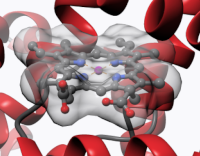Reading List
A list by Biophysics Colab
Articles that are being read by Biophysics Colab.

Showing page 27 of 55 pages of list content
-
-
Structural insights into the orthosteric inhibition of P2X receptors by non-ATP analog antagonists
This article has 8 authors:This article has been curated by 1 group:Reviewed by eLife
-
Conformational dynamics of a nicotinic receptor neurotransmitter site
This article has 5 authors:This article has been curated by 1 group:Reviewed by eLife
-
Biased Signaling in Mutated Variants of β 2 -Adrenergic Receptor: Insights from Molecular Dynamics Simulations
This article has 3 authors: -
-
Structural and mechanistic insights into human choline and ethanolamine transport
This article has 17 authors: -
Fusarium graminearum Ste2 and Ste3 Receptors Undergo Peroxidase Induced Heterodimerization
This article has 5 authors: -
Structure-based discovery of CFTR potentiators and inhibitors
This article has 14 authors: -
Human pannexin 1 channel is not phosphorylated by Src tyrosine kinase at Tyr199 and Tyr309
This article has 5 authors:This article has been curated by 1 group:Reviewed by eLife
-
Activation mechanism of the cardiac calcium pump by a small-molecule allosteric modulator
This article has 5 authors: -
Oligomeric states of an Influenza-encoded PB1-F2 viroporin
This article has 3 authors: -
PI-(3,5)P2-mediated oligomerization of the endosomal sodium/proton exchanger NHE9
This article has 9 authors: -
Negative allosteric modulation of the µ-opioid receptor
This article has 16 authors: -
Conformational changes in the Niemann–Pick type C1 protein NCR1 drive sterol translocation
This article has 9 authors: -
Structural mechanisms for VMAT2 inhibition by tetrabenazine
This article has 4 authors:This article has been curated by 1 group:Reviewed by eLife
-
Structural mechanisms for VMAT2 inhibition by tetrabenazine
This article has 4 authors:This article has been curated by 1 group:Reviewed by eLife
-
-
LRMP inhibits cAMP potentiation of HCN4 channels by disrupting intramolecular signal transduction
This article has 8 authors:This article has been curated by 1 group:Reviewed by eLife
-
The mechanism of Gα q regulation of PLCβ3 -catalyzed PIP2 hydrolysis
This article has 2 authors: -
Step-wise activation of a Family C GPCR
This article has 12 authors: